Big Red
Well-known member
- Sep 27, 2023
- 725
- 460
I had always heard that you should not tow an enclosed cab machine backwards because the rear glass panel was not designed to take the force of the wind at highway speeds. Of course, if it was an open cab machine it would not make a difference. To see if there was any truth to this, I did a Google search, and this is what I found from the Polaris Help Center. It never mentioned the rear glass, but it did state that the roof could blow off. In my case I have to tow my XD facing forward to place the motor and transmission over the trailer wheels, if I would reverse it I would have too much tongue weight. I'll let you decide what works for you.
04/08/2024
If towing a disabled vehicle is unavoidable, place the disabled vehicle's transmission in neutral. If transporting a RANGER XD 1500, disconnect the transmission. Reference your Owner's Manual or read 2024 RANGER XD 1500 Overview for instructions. Tow the shortest distance possible. Do not operate faster than 10 miles per hour (16 kilometers per hour).
Transporting the Vehicle:
Follow these procedures when transporting the vehicle:
1. Apply the brakes.
2. Place the transmission in PARK. Stop the engine.
3. Slowly release the brake pedal and make sure the transmission is in PARK before exiting the vehicle.
4. Remove the key to prevent loss during transportation.
5. Secure the fuel cap and seat. Ensure that the seat is attached correctly and is not loose. Close and latch all doors (if equipped), and secure the front tip out windshield (if equipped). Cargo and other loose vehicle parts may fly off while transporting the vehicle. Secure or remove all cargo, and inspect the unit for loose parts prior to transport.
6. If transporting the vehicle in a non-enclosed or open trailer, the vehicle must FACE FORWARD or the roof must be removed. Failure to comply may allow airflow, vibration or other factors to separate the roof from the vehicle and cause an accident, resulting in serious injury or death.
7. Using suitable straps or rope, always secure the vehicle to the trailer using the designated tie-down points (front and rear). Do not attach tie straps to the A-arm bolt pockets, racks, handlebars or bumpers.
Pictured below are the tie-down points for RANGER XP 1000 models.
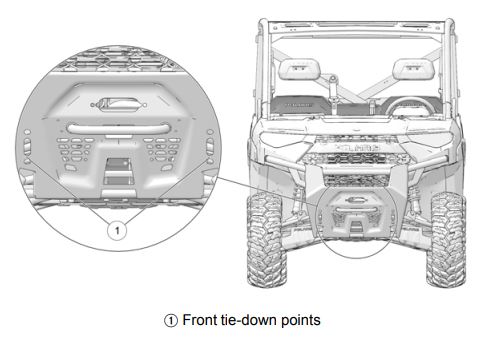
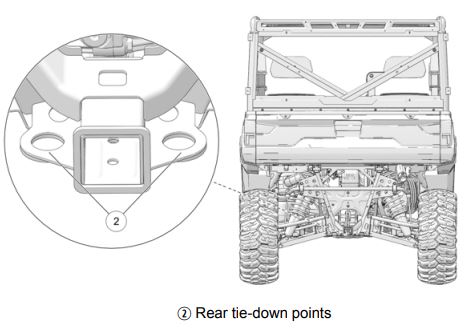
Pictured below are the tie-down points for RANGER 1000 models.
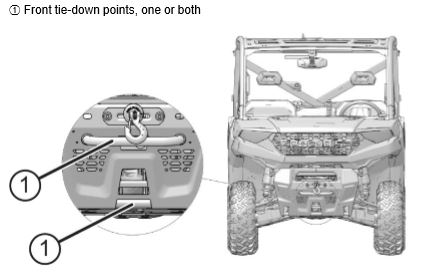
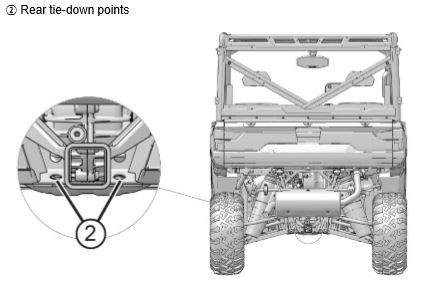
Pictured below are the tie-down points for RANGER XD 1500 models.
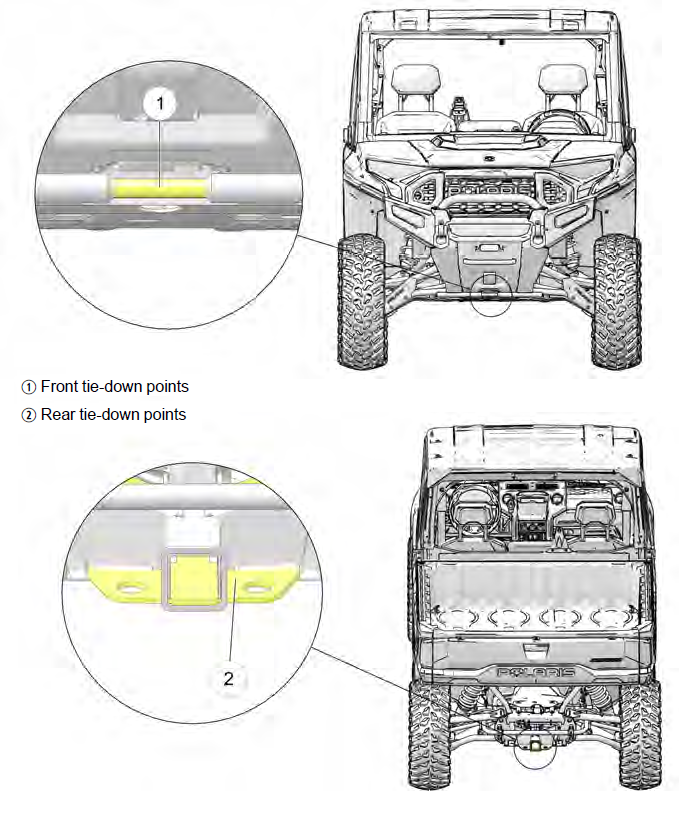
Make sure you know the weight of your cargo and the safe working load limit (WLL) of your straps. The WLL is a measure of the maximum weight the strap can safely handle. The combined WLL of your straps must be greater than the weight of your cargo. If the vehicle weighs 1,000 pounds and you are using four straps, each strap must have a WLL of at least 250 pounds.
Click on the following links for model-specific trailering and transportation instructions.
RANGER 570 Mid-Size and RANGER CREW 570-4
RANGER 1000 and RANGER CREW 1000
Consult your Owner's Manual for specifics as well as transportation guidelines.
Read Choosing the Right Trailer for more information.
To learn more about choosing a trailer and proper trailering techniques, listen to the Happy Trailering to You and Your ORV episode of the Polaris Podcast.
Unless noted, trademarks are the property of Polaris Industries Inc.
© 2022 Polaris Industries Inc.
04/08/2024
Transporting Your RANGER
Towing a Polaris RANGER behind another vehicle is not recommended. Always transport the vehicle on a trailer or flatbed.If towing a disabled vehicle is unavoidable, place the disabled vehicle's transmission in neutral. If transporting a RANGER XD 1500, disconnect the transmission. Reference your Owner's Manual or read 2024 RANGER XD 1500 Overview for instructions. Tow the shortest distance possible. Do not operate faster than 10 miles per hour (16 kilometers per hour).
Transporting the Vehicle:
Follow these procedures when transporting the vehicle:
1. Apply the brakes.
2. Place the transmission in PARK. Stop the engine.
3. Slowly release the brake pedal and make sure the transmission is in PARK before exiting the vehicle.
4. Remove the key to prevent loss during transportation.
5. Secure the fuel cap and seat. Ensure that the seat is attached correctly and is not loose. Close and latch all doors (if equipped), and secure the front tip out windshield (if equipped). Cargo and other loose vehicle parts may fly off while transporting the vehicle. Secure or remove all cargo, and inspect the unit for loose parts prior to transport.
6. If transporting the vehicle in a non-enclosed or open trailer, the vehicle must FACE FORWARD or the roof must be removed. Failure to comply may allow airflow, vibration or other factors to separate the roof from the vehicle and cause an accident, resulting in serious injury or death.
7. Using suitable straps or rope, always secure the vehicle to the trailer using the designated tie-down points (front and rear). Do not attach tie straps to the A-arm bolt pockets, racks, handlebars or bumpers.
Pictured below are the tie-down points for RANGER XP 1000 models.
Pictured below are the tie-down points for RANGER 1000 models.
Pictured below are the tie-down points for RANGER XD 1500 models.

Make sure you know the weight of your cargo and the safe working load limit (WLL) of your straps. The WLL is a measure of the maximum weight the strap can safely handle. The combined WLL of your straps must be greater than the weight of your cargo. If the vehicle weighs 1,000 pounds and you are using four straps, each strap must have a WLL of at least 250 pounds.
Click on the following links for model-specific trailering and transportation instructions.
RANGER 570 Mid-Size and RANGER CREW 570-4
RANGER 1000 and RANGER CREW 1000
Consult your Owner's Manual for specifics as well as transportation guidelines.
Read Choosing the Right Trailer for more information.
To learn more about choosing a trailer and proper trailering techniques, listen to the Happy Trailering to You and Your ORV episode of the Polaris Podcast.
Unless noted, trademarks are the property of Polaris Industries Inc.
© 2022 Polaris Industries Inc.
